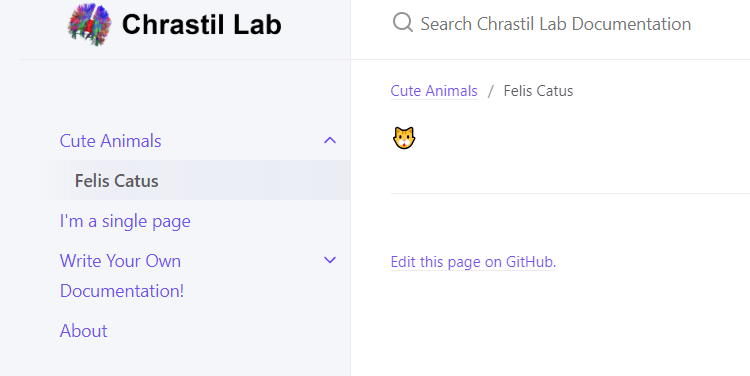How to Add a new Page with child pages
Let’s be more organized by create pages with child pages. For example we want to write some docs on animals
-
Create a folder called
animalsorANIMALSorAniMals(folder name is arbitrary but better keep them in lowercases) -
Create an
index.mdto tell reader what the animals is1 2 3 4 5 6
--- layout: default title: "Cute Animals" nav_order: 0 has_children: true ---
has_children: true: this new attributes is what makes the parent page different from a single page
-
Create an
felis-catus.md1 2 3 4
layout: default title: Felis Catus nav_order: 1 parent: "Cute Animals"
parent: Animals: you must specify the parent page’s title (not folder name)
Here’s our new animal page
Adding a Grandchild Page
In your Jekyll theme, you can create a grandchild page by following these steps. Please note that this example assumes that your theme supports a maximum of three levels of nesting for pages:
-
Create a Folder for the Child: Start by creating a folder for the child page. This folder will contain both the child and grandchild pages. Give this folder a descriptive name related to your content.
1 2 3 4 5 6 7
├── _pages/ │ ├── parent/ │ │ ├── index.md # Parent page │ │ ├── child/ │ │ │ ├── index.md # Child page │ │ │ ├── grandchild/ │ │ │ │ ├── index.md # Grandchild page
-
Create the Child Page: Inside the child folder, create an
index.mdfile for the child page. This is where you will add the content for the child page.1 2 3 4 5 6 7 8 9 10 11
--- layout: default title: Child Page parent: Parent Page grand_parent: Grandparent Page nav_order: 2 --- # Child Page This is the content of the child page.
layout: Set the layout for the child page (e.g.,default).title: Specify the title of the child page.parent: Link the child page to its parent page (Replace “Parent Page” with the actual parent’s title).grand_parent: Link the child page to its grandparent page (Replace “Grandparent Page” with the actual grandparent’s title).nav_order: Determine the order in the navigation (if applicable).
-
Create the Grandchild Page: Inside the
grandchildfolder (inside the child folder), create anindex.mdfile for the grandchild page. This is where you will add the content for the grandchild page.1 2 3 4 5 6 7 8 9 10 11
--- layout: default title: Grandchild Page parent: Child Page grand_parent: Grandparent Page nav_order: 1 --- # Grandchild Page This is the content of the grandchild page.
layout: Set the layout for the grandchild page (e.g.,default).title: Specify the title of the grandchild page.parent: Link the grandchild page to its parent page (in this case, “Child Page”).grand_parent: Link the grandchild page to its grandparent page (in this case, “Grandparent Page”).nav_order: Determine the order in the navigation (if applicable).
-
Navigation and Hierarchy: Depending on your theme and configuration, the navigation and hierarchy of your pages may be automatically generated based on the metadata you provided. Make sure to adjust the
nav_ordervalues to control the order in which these pages appear in the navigation menu.
By following these steps, you can create a grandchild page with proper metadata and hierarchy in your Jekyll theme, allowing for up to three levels of nesting.
